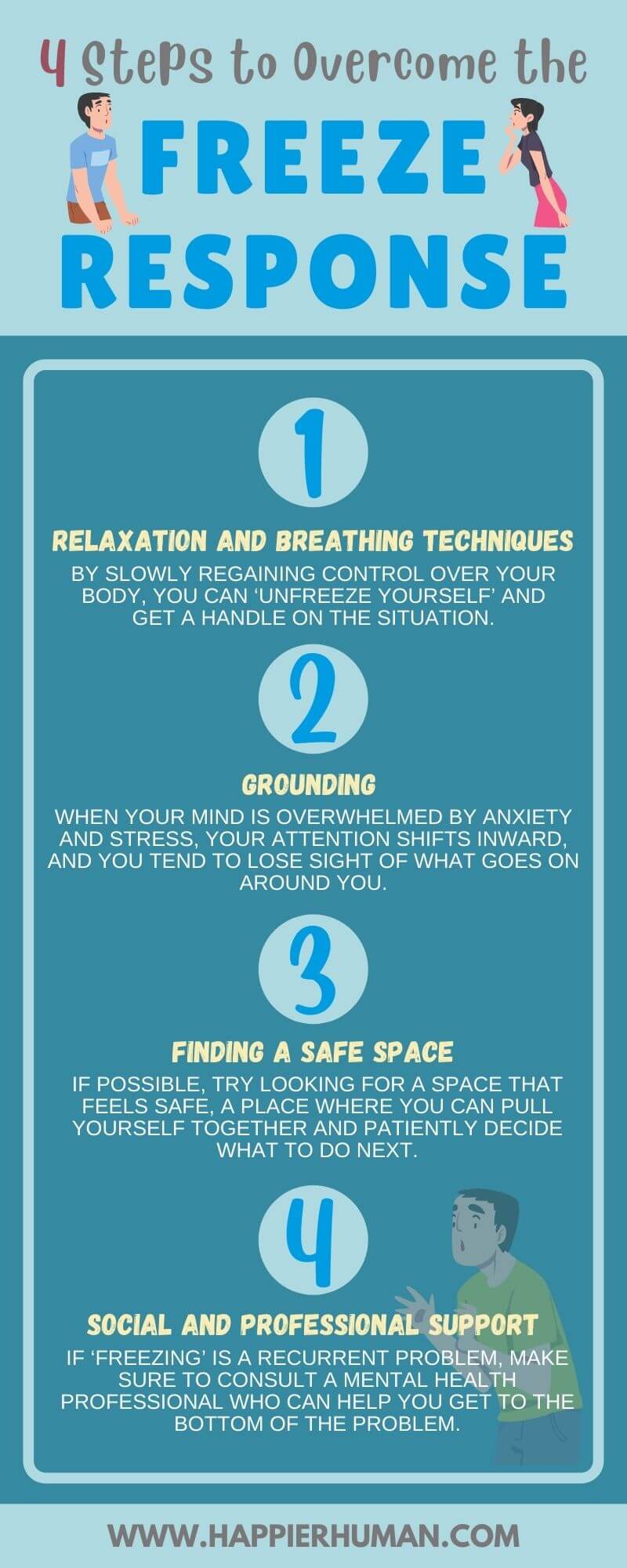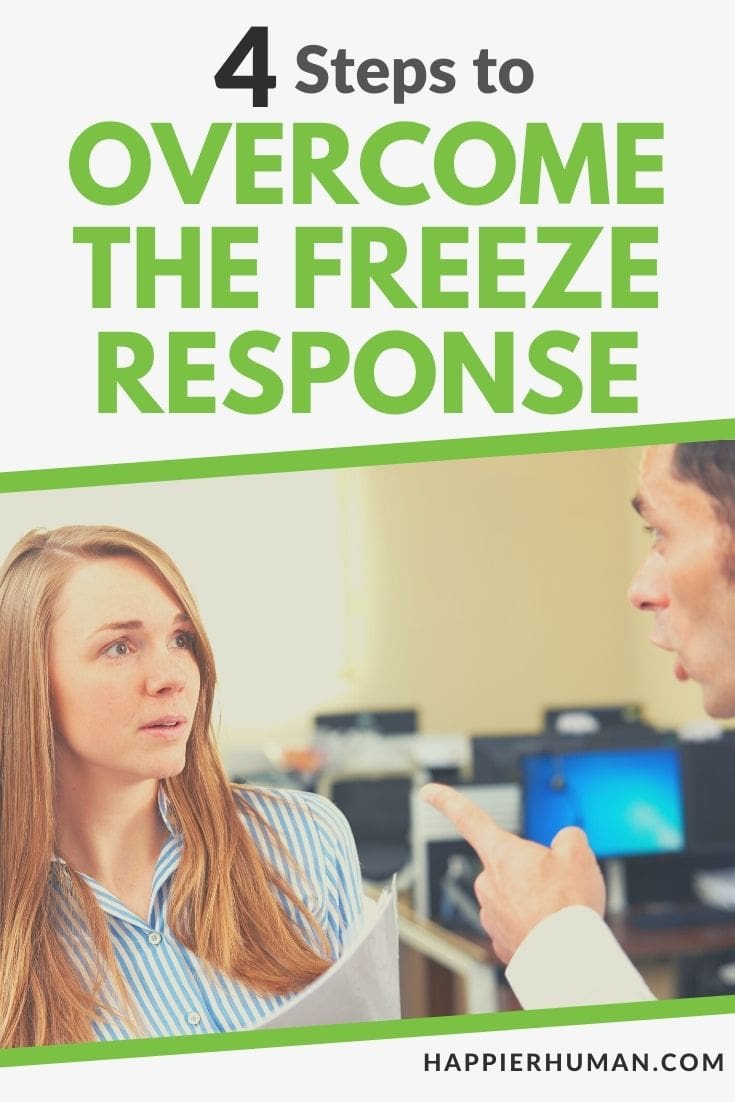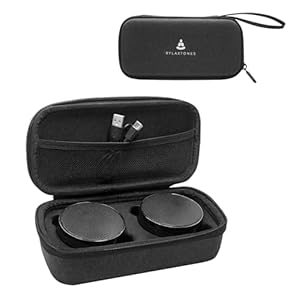You see it in animals all the time. The proverbial “deer in the headlights” where a creature is so overcome by a state of paralysis that they do nothing. Unfortunately, people do this too, and it is important to understand this so that you can overcome your freeze response.
The freeze response is an involuntary stress response, often misunderstood and accompanied by self-blame. Unlike the more recognized burst of energy that comes with fight or fleeing, the freeze response involves a complex shutdown of biological systems that can leave you feeling trapped in your own body, experiencing numbness, rigidity of specific muscles, and what researchers describe as a blank stare into nothingness.
This evolutionary response served our ancestors well when facing a predator, in modern life it can manifest during anxiety disorders, post-traumatic stress disorder, and everyday stressful situations, often leaving individuals questioning why they “can’t hide” from their own reactions and wondering if their response indicates something more serious about their mental health.
Understanding the Fight-Flight-Freeze Response
The freeze response represents a sophisticated type of trauma response that operates alongside the more commonly discussed fight and flight mechanisms. From an evolutionary standpoint, these defense responses form a hierarchy of survival behaviors designed to maximize our chances of survival when facing threats.
While fight and flight responses involve mobilization and a rush of adrenaline surge, the freeze response operates through different biological pathways, primarily involving the parasympathetic nervous system and what polyvagal theory describes as the dorsal vagal complex.
Research by trauma expert Ruth Lanius and others has shown that the freeze response involves immobilization rather than mobilization, representing a form of hypoarousal rather than the hyperarousal seen in fight-or-flight responses. This evolutionary response developed as a rather ingenious survival strategy—when fighting would be futile and escape impossible, freezing could mean the difference between life and death. Animals in the wild demonstrate this same response when playing dead to avoid predators, and humans have retained this capacity as part of our biological inheritance.
The key differences between freeze and other trauma responses lie in their neurobiological signatures and behavioral manifestations. While fight-or-flight responses are characterized by increased heart rate, rapid breath, and hyper-alertness, the freeze response often involves decreased heart rate, shallow breathing, and a distinctive type of awareness where individuals report feeling both hypervigilant and disconnected simultaneously.
What Happens in the Body?
During a freeze response, multiple biological systems undergo dramatic changes as the body shifts into a state of defensive immobilization.
The limbic system, particularly the amygdala, initially detects the threat and triggers the response, but unlike other trauma responses, the freeze reaction involves a unique pattern of nervous system activation.
Heart rate may actually decrease rather than increase, deep breathing becomes shallow or may seem to stop momentarily, and muscle tone can shift dramatically—sometimes involving complete rigidity of specific muscles while others become completely limp. This creates the characteristic posture associated with freeze responses: a person may appear statue-like or collapse entirely.
Neurobiologically, the prefrontal cortex—responsible for executive decision-making—experiences decreased activation during freeze responses, which explains why this reaction feels like anything but a conscious choice. The body’s digestive and other non-essential systems slow down as resources are redirected toward survival, leading to the physical sensations of numbness and disconnection that many people report during and after freeze episodes.
What Happens in the Mind?
The psychological experience of a freeze response involves a unique blend of hypervigilance and dissociation that can be deeply confusing for those experiencing it. Unlike other trauma responses where the mind races with escape plans or defensive strategies, the freeze response often involves what researchers describe as “alert immobility”—a state where cognitive processes become simultaneously heightened and restricted. Individuals may report feeling intensely aware of their surroundings while simultaneously feeling completely disconnected from their own body and emotions.
During freeze responses, the mind often enters a state characterized by minimal verbal cues and internal dialogue. Thoughts may become fragmented or disappear entirely, replaced by a kind of cognitive shutdown that mirrors the physical immobilization occurring in the body. This mental state serves a protective function, potentially shielding the individual from overwhelming vehement emotion or traumatic stimuli that might otherwise cause psychological damage.
The attachment system also plays a crucial role in freeze responses, particularly when they occur in interpersonal contexts. Individuals may find themselves unable to call out for help or seek their attachment figure, trapped in a state where the usual strategies for seeking safety and comfort become inaccessible. This psychological paralysis often leads to significant shame and self-blame afterward, as individuals struggle to understand why they couldn’t simply “snap out of it” or take action to protect themselves.
Here’s What Happens When You ‘Freeze’
The freeze response manifests through a constellation of key signs that distinguish it from other trauma responses, each representing the body’s attempt to survive perceived threats through immobilization. At first glance, someone experiencing a freeze response might appear calm or unaffected, but closer observation reveals the telltale blank stare and unusual stillness that characterizes this survival strategy. The individual becomes trapped between states—neither fully activated for action nor completely at rest—creating a unique form of hyperarousal disguised as shutdown.
Physical manifestations include muscle rigidity or complete limpness, often alternating between the two states unpredictably. Breathing patterns change dramatically, often becoming so shallow that the person appears to have stopped breathing altogether. The characteristic posture of freeze responses can range from statue-like stillness with wide, unblinking eyes to complete collapse where the person cannot maintain their usual physical stance. These responses occur without conscious choice and represent the nervous system’s automatic assessment that neither fighting nor fleeing offers viable survival odds.
The freeze response also involves a distinctive relationship with time and awareness. Individuals often report feeling simultaneously hyperaware of their surroundings—able to notice minute details with unusual clarity—while feeling completely disconnected from their ability to respond or react. This creates an internal experience of being trapped in the present moment, unable to access past coping strategies or imagine future solutions. The result is a form of conscious paralysis that can last anywhere from seconds to hours, depending on the severity of the perceived threat and individual factors.
Is ‘Freezing’ the Sign of a More Serious Problem?
While freeze responses are normal evolutionary reactions that don’t automatically indicate underlying psychological disorders, their frequency, intensity, and impact on daily functioning can signal when professional attention might be beneficial.
Understanding when freeze responses represent adaptive survival mechanisms versus signs of more significant mental health concerns requires examining both the context in which they occur and their broader impact on an individual’s life.
Acute Stress
In situations involving genuine threats or overwhelming acute stress, freeze responses represent healthy, adaptive reactions that demonstrate the nervous system working as designed. These situational freeze responses typically resolve relatively quickly once the threat passes, and individuals can usually return to normal functioning without lasting effects. However, when freeze responses begin occurring in response to minor stressors or in situations where no real threat exists, this may indicate that the nervous system has become dysregulated and is operating from a chronically activated state.
The key factor in determining whether freeze responses to acute stress are concerning lies in their proportionality to the actual threat and their duration. Healthy freeze responses should match the severity of the stressor and resolve naturally as the situation changes. When someone finds themselves freezing in response to everyday stressors like work presentations, social interactions, or minor conflicts, this suggests their threat detection system may need recalibration through therapeutic intervention.
Anxiety
Freeze responses can both contribute to and result from various anxiety conditions, or even depression., creating complex cycles that can be difficult to break without proper understanding and intervention.
In panic disorders, freeze responses may occur as part of the panic cycle, where the fear of having a panic attack itself triggers a freeze response that then escalates into full panic. This creates a self-reinforcing loop where the fear of freezing causes freezing, which then confirms the person’s fears about their inability to cope with challenging situations.
Generalized anxiety and social anxiety frequently involve freeze responses, particularly in interpersonal situations where individuals feel evaluated or judged. The freeze response in these contexts often manifests as an inability to speak, think clearly, or access normally available social skills. While occasional freeze responses during high-anxiety situations are normal, persistent patterns that interfere with work, relationships, or daily activities warrant professional evaluation and treatment.
Traumatic Experiences
The relationship between freeze responses and trauma is particularly complex, as freeze responses can occur during traumatic events, develop as conditioned responses to trauma reminders, and become part of post-traumatic stress disorder symptom clusters.
However, when freeze responses persist long after traumatic events have ended, they may indicate that the nervous system remains stuck in survival mode, interpreting safe situations as threatening based on past experiences. Post-traumatic stress disorder frequently involves freeze responses triggered by trauma reminders, where psychological factors and environmental cues activate the same biological systems that protected the individual during the original trauma. These trauma-related freeze responses often require specialized treatment approaches that address both the underlying trauma and the dysregulated nervous system responses.
4 Steps to Overcome the Freeze Response
Overcoming problematic freeze responses requires a multi-faceted approach that addresses both the immediate experience of freezing and the underlying nervous system patterns that contribute to these reactions. The following strategies work together to help individuals regain agency over their responses and develop greater resilience in the face of stressors.
1. Relaxation and Breathing Techniques
Learning to regulate the breath provides one of the most accessible and effective tools for interrupting freeze responses and supporting nervous system recovery. When caught in a freeze response, the breath often becomes shallow or seems to stop entirely, contributing to the sense of being trapped and unable to act. Developing a relationship with conscious breathing helps bridge the gap between the involuntary freeze response and voluntary return to normal functioning.
Specific breathing techniques that support recovery from freeze responses include diaphragmatic breathing, which helps activate the parasympathetic nervous system’s calming branch rather than its immobilizing branch. Box breathing—inhaling for four counts, holding for four, exhaling for four, and holding empty for four—provides a structured way to regain control over physiological responses. Progressive muscle relaxation can also help address the rigidity of specific muscles that occurs during freeze responses, systematically releasing tension and restoring normal muscle tone.
The key to success with breathing techniques lies in practicing them regularly during calm periods, not just during crisis moments. This creates neural pathways that become more accessible during stress, providing reliable tools for nervous system regulation when they’re most needed.
2. Grounding
Grounding techniques help individuals reconnect with the present moment and their physical body, counteracting the dissociative aspects of freeze responses. These techniques work by engaging the senses and providing concrete, immediate experiences that anchor awareness in current reality rather than threat-based perceptions. Effective grounding approaches include the 5-4-3-2-1 technique: identifying five things you can see, four things you can touch, three things you can hear, two things you can smell, and one thing you can taste.
Physical grounding techniques can be particularly effective for freeze responses, as they help restore the connection between mind and body that becomes disrupted during these episodes. Pressing feet firmly into the floor, holding a textured object, or applying gentle pressure to arms or legs can help reestablish bodily awareness. Cold water on the face or hands, strong mints, or other intense but safe sensory experiences can help “wake up” a nervous system caught in freeze mode.
Movement-based grounding, even small movements like wiggling fingers or toes, can help begin the process of coming out of freeze responses. The goal is not to force dramatic changes but to gently encourage the nervous system to remember its capacity for voluntary action and response.
3. Finding a Safe Space
Creating and identifying safe spaces—both physical and psychological—provides crucial support for preventing and recovering from freeze responses. A safe space might be a specific location where freeze responses are less likely to occur, or it might be an internal sense of safety cultivated through various therapeutic practices. The concept of safety is central to freeze response recovery because these responses typically occur when the nervous system perceives threat and determines that neither fight nor flight responses offer viable paths to safety.
Physical safe spaces should be easily accessible and associated with positive, calming experiences. This might involve creating a specific corner of a home with comfortable seating, meaningful objects, and pleasant sensory experiences. The key is consistency—having a reliable place to retreat when overwhelmed helps the nervous system learn that safety is available and accessible.
Psychological safe spaces involve developing internal resources for self-soothing and nervous system regulation. This might include visualization techniques, positive self-talk, or connecting with internalized images of supportive relationships. Professional therapy can be particularly helpful in developing these internal resources, especially for individuals whose freeze responses are related to past trauma or attachment difficulties.

4. Social and Professional Support
Recovering from problematic freeze responses often requires support from others, both personal connections and professional resources. Social support provides external regulation when internal resources become overwhelmed, helping to co-regulate nervous systems through connection with calm, supportive others. This support might come from trusted friends, family members, or support groups where individuals can share their experiences without judgment and learn from others who have faced similar challenges.
Professional support becomes essential when freeze responses significantly impact daily functioning or are related to underlying trauma or mental health conditions. Trauma-informed therapists who understand the nuanced nature of freeze responses can provide specialized interventions that address both the symptoms and their underlying causes. Therapeutic approaches like EMDR (Eye Movement Desensitization and Reprocessing), somatic experiencing, and polyvagal-informed therapy have shown particular effectiveness in helping individuals overcome problematic freeze responses.
The process of seeking support itself can be challenging for individuals prone to freeze responses, as the vulnerability required to reach out can trigger the very responses they’re seeking to address. Starting with small steps—perhaps reaching out to one trusted person or scheduling an initial consultation with a therapist—can help build momentum toward more comprehensive support. Remember that healing from freeze responses is rarely a solitary endeavor; the human nervous system is designed to heal in relationship with others, making social and professional support not just helpful but often essential components of recovery.
How to handle the freeze response.
The freeze response, far from being a sign of weakness or failure, represents one of humanity’s most sophisticated survival mechanisms—a testament to the remarkable adaptability of our nervous system in the face of perceived threats.
Understanding this evolutionary response through the lens of modern neuroscience and trauma research helps illuminate why so many individuals find themselves trapped in states of immobilization during stressful situations, often accompanied by shame and confusion about their body’s automatic reactions.
By recognizing freeze responses as involuntary biological processes rather than character flaws, we can begin to approach them with compassion and curiosity rather than judgment and self-blame. The journey from freeze to freedom involves patience, practice, and often professional guidance, but with proper awareness of the fact that healing is possible, individuals can learn to work with their nervous system rather than against it.
Whether your freeze responses stem from acute stress, anxiety, or traumatic experiences, remember that your body’s protective mechanisms developed over millions of years of evolution—and with the right tools and support, you can help your nervous system learn new, more adaptive ways of responding to life’s challenges while honoring the wisdom of your biological inheritance.
Now, it’s important to figure out if your freeze response relates to some sort of anxiety. If you feel like it might be, then you should understand what type of anxiety you’re experiencing (this article will help) and also use the 3-3-3 rule to provide a quick relief when you have those anxious moments.
Learn more about how gratitude can positively impact your life and mental wellbeing.
Finally, if you want to increase your happiness and life satisfaction, then watch this free video that details the 7-minute habit for planning your day to focus on what’s important.

References
[1] K. Roelofs, “Freeze for action: neurobiological mechanisms in animal and human freezing,” Philosophical Transactions of the Royal Society B, vol. 372, no. 1718, 2017.
[2] L. M. Gladwin, E. J. Hermans and E. J. Roelofs, “Freezing promotes perception of coarse visual features,” Journal of Experimental Psychology, vol. 144, no. 6, p. 1080–1088, 2015.
[3] A. Krause-Utz, R. Frost, D. Winter and B. M. Elzinga, “Dissociation and Alterations in Brain Function and Structure: Implications for Borderline Personality Disorder,” Current Psychiatry Reports, vol. 19, no. 1, 2017.
[4] K. Kozlowska, P. Walker, L. McLean and P. Carrive, “Fear and the Defense Cascade: Clinical Implications and Management,” Harvard Review of Psychiatry, vol. 23, no. 4, p. 263–287, 2015.
[5] N. B. Schmidt, A. Richey, M. J. Zvolensky and J. K. Maner, “Exploring human freeze responses to a threat stressor,” Journal of Behavior Therapy and Experimental Psychiatry, vol. 39, no. 3, pp. 292-304, 2008.
Trending Products

Chimes Set of 4 – Handmade Wind C...

BEST 100 Daily Meditation Cards | A...

Melous 4 in 1 Sandalwood Gua Sha Ma...

rylaxtones Carrying Case Travel Cas...

ProsourceFit Acupressure Mat and Pi...

Mindfulness Breathing Necklace Stre...

Woodstock Wind Chimes Zenergy Hand ...

ENFANTRY Breathing necklace Mindful...

TNZMART Hanging 9 Note Sound Healin...





